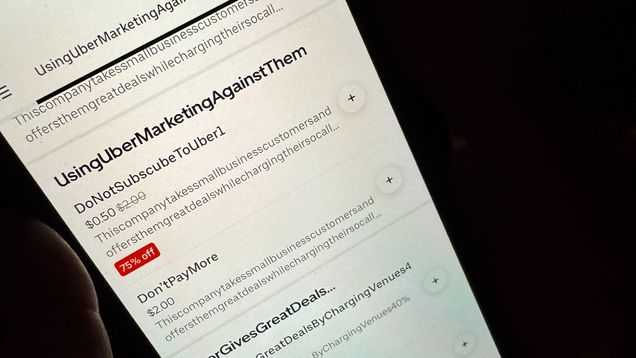
You probably expect menus to list dishes, not business advice.
You definitely don’t expect to find a public service announcement wedged between butter chicken and beef burgers.
But that’s exactly what customers discovered when they opened Inferno Grill’s Uber Eats menu in Maroubra, Sydney.
A Bold Protest Against Hidden Fees
Inferno Grill’s unusual approach shone a spotlight on a little-known reality: delivery apps take about 30 per cent of every order from restaurants, and most businesses increase their prices on these platforms to offset the cost.
Instead of promoting their lamb kebabs and grilled meats, the restaurant used its menu to warn customers about Uber Eats’ hefty fees and encourage them to order directly or visit in person.
Uber Eats offers restaurants several partnership plans with varying commission rates. The Lite Plan charged 15 per cent for delivery orders, the Plus Plan 25 per cent, and the Premium Plan a staggering 30 per cent. Pickup orders on all plans came with a 6 per cent charge.
Restaurants faced other costs too. New locations paid a $500 activation fee excluding GST, deducted in weekly instalments, and potential damage fees of $200. Marketing fees were also applied if restaurants wanted better visibility on the platform.
'Almost one-third of your earnings are gone before you even see it.'
Financial pressure forced many restaurants to increase prices significantly on delivery apps. Some raised menu prices by over 50 per cent, and research across 20 restaurants in Sydney's Newtown found markups ranging from 3 per cent to 52 per cent.
The Real Cost to Customers
For diners, these extra costs added up fast. The service fee alone typically hovered around 15 per cent of the subtotal, varying by city and restaurant. Delivery fees, small order fees, and extra charges during busy periods compounded the total.
The real cost of convenience
Australians who ordered takeaway spent an average of $71 per week, equivalent to $3,692 annually.
If all their orders were placed through food delivery apps, they would pay an extra $1,228 each year before service and delivery fees were added.
Nationwide, this could mean an extra $16 billion annually if all takeout orders were delivered via apps.
Restaurants Fighting Back
Inferno Grill was not alone. Earlier this year, Sydney’s Super Nash Brothers spoke on #A Current Affair about similar struggles with Uber Eats’ rising fees and restrictive policies.
Owners Ross Kemp and Joe Avers said Uber Eats introduced a 33 per cent charge, mandatory advertising fees when visibility dropped, and extra 'offer fees' when customers used promotions. They also implemented a 'merchant success score' that could limit restaurant visibility depending on price markups.
'We need to pay staff, we need to pay power bills, we need to pay rent and everything else. And Joe and I would like to make a little something at the end of the month as well,' Ross said.
How Fees Affect Your Wallet
Smart ways to save on food delivery
- Choose restaurants closer to you for lower delivery fees
- Meet small order minimums by adding a cheap item rather than paying the small order fee
- Group orders with family or friends to spread fixed fees across larger orders
- Consider Uber One membership ($9.99/month) for $0 delivery fees on eligible orders over $15
- Order during off-peak hours to avoid 'Busy Area' fees
The Restaurant Perspective
Inferno Grill’s cheeky menu messages revealed the frustration many small business owners feel. Delivery platforms positioned themselves as partners while taking cuts that could make or break profitability.
Uber One, the platform’s paid membership program, offered benefits such as $0 delivery fees, but these benefits did not always apply to specific restaurants, adding further uncertainty.
What You Can Do
Delivery apps provide convenience, especially for people with mobility issues or busy schedules, but knowing the true costs can help you make smarter choices.
Calling restaurants directly to ask about their own delivery services or pickup options could save money and often improve service. Many restaurants offered online ordering or phone-based delivery that cut out the middleman entirely.
If you used delivery apps, checking multiple platforms before placing large orders was worthwhile, as fees varied between Uber Eats, DoorDash, and Menulog.
The next time you considered ordering in, remember Inferno Grill’s protest—sometimes the priciest part of a meal is the convenience fee, not the food.
What This Means For You
Inferno Grill’s unusual menu protest shone a light on the hidden costs of food delivery apps, revealing how platforms take up to 30 per cent commission along with extra marketing and activation fees.
These charges often force restaurants to raise their prices, which means customers end up paying more for the convenience of having their meals delivered. By ordering directly from restaurants or using strategies like grouping orders with family or friends, diners can reduce these costs while also supporting local businesses.
For audiences looking to save money and get better service, understanding these hidden fees can make a real difference to your weekly takeaway budget.
If you found Inferno Grill’s menu protest eye-opening, you might be interested in another story highlighting hidden costs on food delivery apps.
This piece dives into real-life experiences where delivery fees and service charges caught customers off guard, showing how widespread the issue really is.
It’s a practical follow-up for anyone looking to understand the true price of convenience when ordering in.
Read more: Aussies hit with hidden Uber Eats fees: 'Still can't quite compute their maths'
Hidden $1,200 Uber Eats charge too many Aussie are copping: 'Quickly adds up' — Explains how delivery apps take about 30 per cent of each order, causing many restaurants to increase menu prices to offset costs.
https://au.finance.yahoo.com/news/h...ie-are-copping-quickly-adds-up-190008732.html
How Much Does Uber Eats Charge Restaurants? Fees Explained — Details the different partnership plans Uber Eats offers to restaurants, including Lite, Plus, and Premium with varying commission rates.
https://orders.co/blog/how-much-uber-eats-charges-restaurants/
Pricing That Works for Your Business | Uber Eats — Outlines additional costs for restaurants, including a $500 activation fee for new locations and potential damage fees.
https://merchants.ubereats.com/au/en/pricing/
Uber Eats Fees Explained: A Complete 2025 Breakdown — Provides insight into service fees, delivery markups, and strategies for customers to reduce costs, such as grouping orders or using Uber One membership.
https://flavor365.com/uber-eats-fees-explained-a-complete-2025-breakdown/
Hidden $1,200 Uber Eats charge too many Aussie are copping: 'Quickly adds up' — Offers research on price markups across multiple restaurants, showing increases ranging from 3 per cent to over 50 per cent on delivery apps.
https://au.finance.yahoo.com/news/h...ie-are-copping-quickly-adds-up-190008732.html
Have you noticed restaurants in your area offering direct delivery or pickup services? Share your experiences in the comments—your insights could help others make smarter dining choices.







